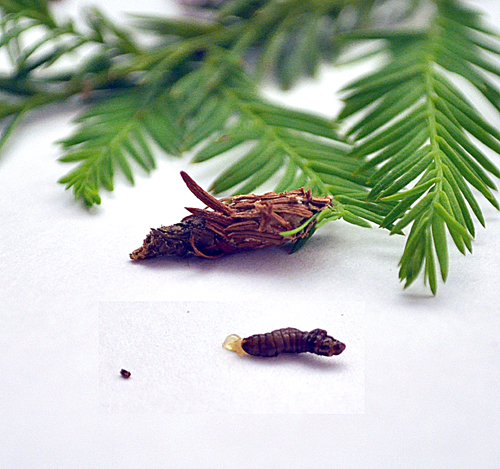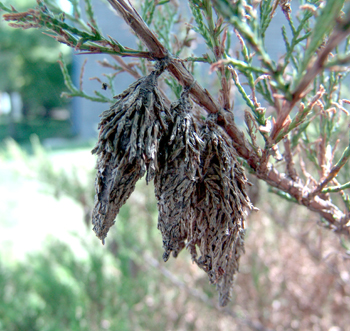Bagworms
Return to Insect Agent Articles
 A few years ago a call came into the office from a woman in distress about foliage on a tree that had disappeared overnight. It had been eaten by a large brown worm in some sort of web-like bag hanging from the branch. How did this insect develop so quickly, she wanted to know? The insect she was describing was more than likely the bagworm, one of the most commonly recognized tree and shrub pests.
A few years ago a call came into the office from a woman in distress about foliage on a tree that had disappeared overnight. It had been eaten by a large brown worm in some sort of web-like bag hanging from the branch. How did this insect develop so quickly, she wanted to know? The insect she was describing was more than likely the bagworm, one of the most commonly recognized tree and shrub pests.
Although their damage seems to materialize quickly, the fact is, bagworms are easy to spot if one is paying close attention to the plant. Bagworm problems start out small, but given a couple years to spread, can clean the foliage from a juniper in a matter of days. In fact, from a single old bag, close to a thousand new bagworms can hatch and start to feed.
Bagworms feed on a number of different plants in the landscape, but most commonly they can be found on junipers, arborvitae, spruce and pine. They will even feed on deciduous plants like roses and oak. As they feed they grow in size becoming more destructive, more noticeable and harder to control.
Bagworm life cycle in Kansas City
 Bagworm eggs hatch in late May or early June, which makes this the ideal time to eradicate them. Soon after hatching, a worm about the size of a pencil lead starts eating the foliage. As the worm grows it spins a silken bag around its body, camouflaged with bits and pieces of the host foliage. By late summer the bag may be several inches long and become impossible to control.
Bagworm eggs hatch in late May or early June, which makes this the ideal time to eradicate them. Soon after hatching, a worm about the size of a pencil lead starts eating the foliage. As the worm grows it spins a silken bag around its body, camouflaged with bits and pieces of the host foliage. By late summer the bag may be several inches long and become impossible to control.
How to kill bagworms  Control after hatching is ideal due to the fact that they are small and no measurable plant damage has occurred. At this time of the year there are numerous products on the market to control bagworms ranging from cyfluthrin, Malathion, Orthene, Sevin or even an organic product Bacillus thuringiensis.
Control after hatching is ideal due to the fact that they are small and no measurable plant damage has occurred. At this time of the year there are numerous products on the market to control bagworms ranging from cyfluthrin, Malathion, Orthene, Sevin or even an organic product Bacillus thuringiensis.
Proper coverage is important for good control. The bagworms can be feeding toward the outside or even work their way into the interior branches of the plant. Apply a thorough covering of the spray mixture to soak the small developing bags for best results.
As the bags become larger control is more difficult. A mature bag will repel the chemicals making them useless. By the arrival of fall the only method of control is to hand pick and remove the developing bags.
Do not be caught by surprise late in the season when the damage is done. Take a few minutes and walk through the landscape inspecting the plants closely for the signs of bagworms. This will help head off big problems and save you time and money in the long run.
Have questions?
The Garden Hotline is staffed by trained EMG volunteers and Extension staff who will assist you with questions.
Phone: (913) 715-7050
Email: garden.help@jocogov.org